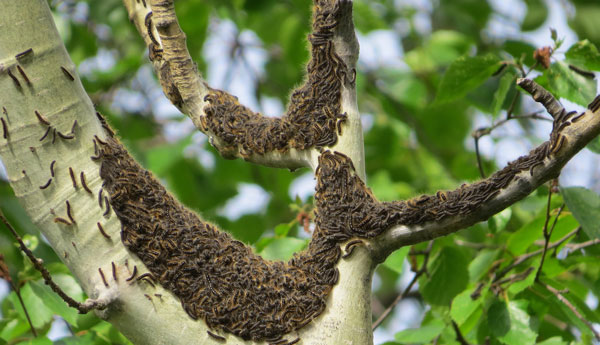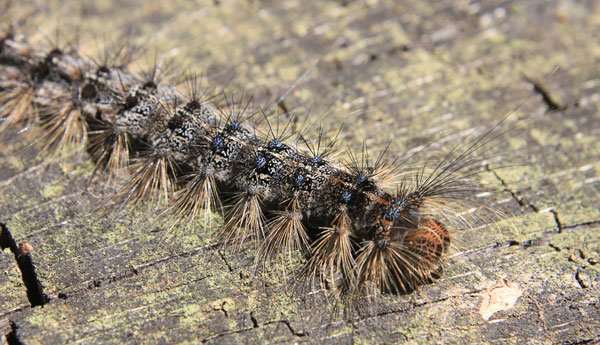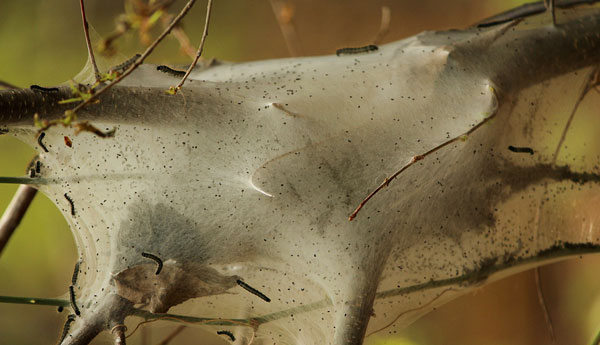
I sometimes have the chance to peruse the comments on my articles (and, when I can figure out the controls on the #&*@ing content management system, even manage to respond to a few). As it happens, I was going over the comments on my last posting and noticed a potential confusion between bagworms, and Eastern Tent Caterpillars. Its a common mistake, and one I made myself until adulthood, as my grandfather constantly referred to both varieties simply as “bagworms.” Tent caterpillars, however, with their wispy white wigwams nestled high in the trees, are another beast entirely. Today, lets take a look at these tree-born parasites, and how best to keep them under control.

To begin with, I have some bad news (if you’re reading this soon after I’ve posted, anyhow). The tent caterpillars in your area are likely already quite active. Beginning in early spring, the worms spin silky tents of web between the branches of trees or bushes, where they reside in a dense, writhing mass. Unfortunately, they have a real penchant for wild cherry trees, ornamental fruit trees, the already blighted ash tree, as well as maples and willows.
Once embedded, the caterpillars will feed on the trees leaves, causing mass defoliation. Once they finish their host tree, they’ll move on to neighbors to find food. While this practice wont kill a tree outright, it will make it far more susceptible to disease. The caterpillars follow the practice of most insects, sleeping in their nests at night, and venturing out during the day to wreak havoc–I mean feed–on your tree leaves.
Control Practices
When I was a kid, we had a very simple method of tent-caterpillar control–it involved a can of gum cutter and a lighter. In truth, while I cannot recommend this method, as it is dangerous to both the tree, the forest and the can-holder, it was quite effective as it did a great job melting both the highly flammable nests, and egg cases. Nonetheless, its efficacy does inform what’s required to fully remove a nest–take a stick and wind the nest around it, then drop it into a bucket of soapy water. This is best done at either dawn or dusk, when the caterpillars are still mostly in the nest.

Sometimes you have to go further. Much like with bagworms, bacillus thuringiensis is very effective at selectively killing tent caterpillars. Spray it directly on the nest, as well as on surrounding foliage for best effects. Again, twilight is the best time to ensure you get the largest amount of caterpillars.
Finally, the third way to stop this marauders is to hit them before they hatch. As with most caterpillars, these buggers (pun intended) eventually turn into moths, in which stage they deposit overwintering eggs in small sticky masses on branches (there are none currently around, and I do not have a picture of one handy, but check out this link to see what they look like). These egg masses remain for the end part of summer, and all of fall and winter until they hatch in the spring. Tear them off by hand at any point during this time, and you have stopped the life cycle of a large number of tent caterpillars right in their grimy tracks.
Good luck and Godspeed. Tent caterpillars are one of my least favorite nuisances, and while their population can be managed, it can never realistically be eradicated from your homestead. That said, there’s no harm in aspiring for the impossible!
A humble homesteader based in an undisclosed location, Lars Drecker splits his time between tending his little slice of self-sustaining heaven, and bothering his neighbors to do his work for him. This is mainly the fault of a debilitating predilection for fishing, hunting, camping and all other things outdoors. When not engaged in any of the above activities, you can normally find him broken down on the side of the road, in some piece of junk he just “fixed-up.”

Stanley Fillips says
In our area the tent caterpillars are high up in some of our trees (50 feet plus) and are impossible to get to. anyone have any ideas how to get to them????
Pete in NC says
Mil-surp flame-thrower.
George says
Dispel (Bt) will control Eastern Tent Caterpillar if you spray the surrounding leaves and spray with enough pressure to break open the web.